Giacomo Baroffio
Introduzione al canto gregoriano
Cantori
Giacomo Baroffio - Eun Ju Kim
Podcasting
Link per l'ascolto
Radio Vaticana Programmi Musicali
01: 140202] http://media01.radiovaticana.va/audiomp3/00410953.MP3
introduzione: il canto gregoriano
melodia del passato - canto nel presente - preghiera di sempre
preghiera nata nell’Ebraismo e accolta nella Chiesa
centralità della Parola - la missione profetica del cantore
iniziali nei manoscritti, abecedari della fede
Introito Ad te levavi cfr. Graduale Triplex 10 [(12’55’’)15’50’’]
Comunione In splendoribus cfr. Graduale Triplex 25 [24’10’’]
02: 140209] http://media01.radiovaticana.va/audiomp3/00410954.MP3
alle origini del canto liturgico
canto monodico e polivocale - il cantore iconografo
tradizione orale e trasmissione scritta
cantillazione biblica - toni di lettura
Introito Ad te levavi: Caudae cfr. MS Verbania/Intra, S. Vittore [(11’05’’) 12’02’’]
Toni di lettura:
epistola cfr. Graduale Triplex 405 [(19’15’’) 19’47’’]
Genealogia di san Matteo cfr. MS Sant’Ambrogio (Torino) [(22’00’’) 22’45]
Antifona Pueri Hebraeorum cfr. Graduale Triplex 138. 140 [(24’50) 25’10’’]
03: 140216] http://media01.radiovaticana.va/audiomp3/00410955.MP3
tradizione e trasmissione
una cantillazione ebraica nel triduo pasquale cristiano
canto beneventano - canto romano-antico - canto ambrosiano
melodie mediterranee arcaiche
Tropo di Kyrie Qui passurus cfr. MS Roma, Bibl. Vallicelliana, C 13, 396vb (sec. XII,
Sant’Eutizio in Valcastoriana) [(00.25’’) 2’42’]
Offertorio Angelus Domini
recensione gregoriana cfr. Graduale Triplex [8’15’’]
recensione beneventana (inizio) cfr. MS Benevento 38, 53r (sec. XI) [13’00’’]
recensione romano-antica (inizio) cfr. MS BAV, Arch. S. Pietro, F 22, 54v (sec. XIII)
[14’13’’; 15’16’’; 15’42’’; 16’52’’ ]
Transitorio (canto di comunione ambrosiano) Te laudamus cfr. Antiphonale Missarum [19’25’’]
04] 140223 http://media01.radiovaticana.va/audiomp3/00410956.MP3
spazi e tempi per cantare
anno liturgico - antifona: chiave di lettura dei salmi
antifona e salmodia - toni salmodici - trasposizione di melodie gregoriane
antifona narrativa (senza salmodia)
Antifone in mi tipiche dell’avvento, scritte al la
Ex Aegypto vocavi cfr Antiphonale monasticum 194 IV[2’27’’]
Sion noli timere cfr Antiphonale monasticum 194 IV [2’50’’]
Quaerite Dominum cfr Antiphonale monasticum 192 IV [3’11’’]
Tono salmodico
semplice (esempio in sol) [10’; 17’13’’, 18’57’’]
cadenze della salmodia semplice [13’30’’]
tono peregrino con due tenori [17’40]
fiorito con due tenori nei versi di responsorio [19’12’’]
Antifone narrative
O quando in cruce di Sofronio, patriarca di Gerusalemme († 638) cfr MS Norcia, Archivio
Storico Comunale, Notarile 1612 (sec. XI) [(20’35’’) 21’55’’ ]
O beata infantia cfr. Variae Preces 88 [25’33’’ ]
05] 140302 http://media01.radiovaticana.va/audiomp3/00410957.MP3
la corsa gloriosa della Parola e la risonanza orante nella liturgia
responsori: canto e ascolto - responsori prolissi e brevi - struttura dei responsori
historiae - uffici con progressione modale dei canti
Responsori prolissi (nell’ora notturna)
Videbant omnes Stephanum (responso) s. Stefano cfr. MS Klosterneuburg 1013, ed. Hiley, Western
Plainchant 72 [9’34’’]
Cum complerentur (elementi strutturali) Pentecoste cfr Liber Responsorialis 109 [(11’05’’) 11’48’’]
Repleti sunt omnes (elementi strutturali) Pentecoste cfr Antiphonale monasticum 1187 [(15’40’’)
16’37’’]
Responsori brevi
tono solenne Verbum caro (integrale) Natale cfr Antiphonale monasticum 248 [23’30’’]
tono semplice Verbum caro (integrale) Natale cfr Antiphonale monasticum 242 [25’15]
06] 140309 http://media01.radiovaticana.va/audiomp3/00410958.MP3
fede e poesia negli inni
la Chiesa di Milano - l’esperienza monastica benedettina
la liturgia della Chiesa universale
Inni
Veni redemptor Natale, s. Ambrogio, vescovo di Milano ( † 397) cfr Liber Hymnarius, 11 [6’35’’]
Christe redemptor Natale, sec. VI cfr Liber Hymnarius, 14 [8’30’’]
Ut queant laxis Paolo Diacono († 799) / Guido d’Arezzo († 1050 ca.) [(11’24’’) 14’50’’ ]
Unica spes hominum ritmo paratterico, testo di s. Pier Damiani († 1072); la melodia è stata ricuperata dall’inno di Venanzio Fortunato Crux benedicta nitet [(21’00’’) 27’03’’]



